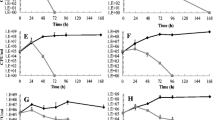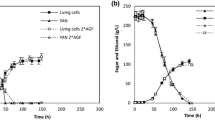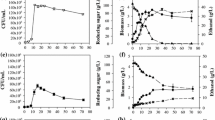Abstract
The nature of the toxic compounds produced by Saccharomyces cerevisiae CCMI 885 that induce the early death of Hanseniaspora guilliermondii during mixed fermentations, as well as their ability to inhibit the growth of other non-Saccharomyces wine-related strains, was investigated. The killing effect of mixed supernatants towards H. guilliermondii was inactivated by protease treatments, thus revealing the proteinaceous nature of the toxic compounds. Analysis of the protein pattern of mixed supernatants on Tricine SDS-PAGE showed that this S. cerevisiae strain secretes peptides (<10 kDa), which were detected only when death of H. guilliermondii was already established. Death-inducing supernatants were ultrafiltrated by 10 and 2 kDa membranes, respectively, and the inhibitory effect of those permeates were tested in H. guilliermondii cultures. Results indicated that the (2–10) kDa protein fraction of those supernatants seemed to contain antimicrobial peptides active against H. guilliermondii. Thus, the (2–10) kDa protein fraction was concentrated and its inhibitory effect tested against strains of Kluyveromyces marxianus, Kluyveromyces thermotolerans, Torulaspora delbrueckii and H. guilliermondii. Under the growth conditions used for these tests, the (2–10) kDa protein fraction of S. cerevisiae CCMI 885 supernatants exhibited a fungistatic effect against all the strains and a fungicidal effect against K. marxianus.





Similar content being viewed by others
References
Arneborg N, Siegumfeldt H, Andersen GH, Nissen P, Daria VR, Rodrigo PJ, Gluckstad J (2005) Interactive optical trapping shows that confinement is a determinant of growth in a mixed yeast culture. FEMS Microbiol Lett 245:155–159
Bauer FF, Pretorius IS (2000) Yeast stress response and fermentation efficiency: how to survive the making of wine—a review. S Afr J Enol Viticult 21:27–51
Bisson LF (1999) Stuck and sluggish fermentations. Am J Enol Viticult 50:107–119
Capece A, Fiori C, Maraz A, Romano P (2005) Molecular and technological approaches to evaluate strain biodiversity in Hanseniaspora uvarum of wine origin. J Appl Microbiol 98:136–144
Chen WB, Han YF, Jong SC, Chang SC (2000) Isolation, purification, and characterization of a killer protein from Schwanniomyces occidentalis. Appl Environ Microbiol 66:5348–5352
Ciani M, Fatichenti F (2001) Killer toxin of Kluyveromyces phaffii DBVPG 6076 as a biopreservative agent to control apiculate wine yeasts. Appl Environ Microbiol 67:3058–3063
Ciani M, Pepe V (2002) The influence of pre-fermentative practices on the dominance of inoculated yeast starter under industrial conditions. J Sc Food Agric 82:573–578
Comitini F, Ferretti R, Clementi F, Mannuzzu I, Ciani M (2005) Interactions between Saccharomyces cerevisiae and malolactic bacteria: preliminary characterization of a yeast proteinaceous compound(s) active against Oenococcus oeni. J Appl Microbiol 99:105–111
Edwards CG, Beelman RB, Bartley CE, McConnell AL (1990) Production of decanoic and other volatile compounds and the growth of yeast and malolactic bacteria during vinification. Am J Enol Vitic 41:48–56
Egli CM, Edinger WD, Mitrakul CM, Henick-Kling T (1998) Dynamics of indigenous and inoculated yeast populations and their effect on the sensory character of Riesling and Chardonnay wines. J Appl Microbiol 85:779–789
Enrique M, Marcos JF, Yuste M, Martínez M, Vallés S, Manzanares P (2007) Antimicrobial action of synthetic peptides towards wine spoilage yeasts. Int J Food Microbiol 118:318–325
Fleet GH (2003) Yeast interactions and wine flavour. Int J Food Microbiol 86:11–22
Fleet GH, Heard GM (1993) Yeast growth during fermentation. In: Fleet GH (ed) Wine microbiology and biotechnology. Harwood Academic Publishers, Switzerland, pp 27–54
Granchi L, Ganucci D, Messini A, Vincenzini M (2002) Oenological properties of Hanseniaspora osmophila and Kloeckera corticis from wines produced by spontaneous fermentations of normal and dried grapes. FEMS Yeast Res 2:403–407
Hansen EH, Nissen P, Sommer P, Nielsen JC, Arneborg N (2001) The effect of oxygen on the survival of non-Saccharomyces yeasts during mixed culture fermentations of grape juice with Saccharomyces cerevisiae. J Appl Microbiol 91:541–547
Kimura T, Kitamoto N, Matsuoka K, Nakamura K, Iimura Y, Kito Y (1993) Isolation and nucleotide-sequences of the genes encoding killer toxins from Hansenula mrakii and H. saturnus. Gene 137:265–270
Lambrechts MG, Pretorius IS (2000) Yeast and its importance to wine aroma—a review. S Afr J Enol Vitic 21:97–129
Lema C, Garcia-Jares C, Orriols I, Ângulo L (1996) Contribution of Saccharomyces and non-Saccharomyces populations to the production of some components of Albarino wine aroma. Am J Enol Vitic 47:206–216
Marquina D, Santos A, Peinado JM (2002) Biology of killer yeasts. Int Microbiol 5:65–71
Navarro L, Zarazaga M, Saenz J, Ruiz-Larrea F, Torres C (2000) Bacteriocin production by lactic acid bacteria isolated from Rioja red wines. J Appl Microbiol 88:44–51
Nissen P, Arneborg N (2003) Characterization of early deaths of non-Saccharomyces yeasts in mixed cultures with Saccharomyces cerevisiae. Arch Microbiol 180:257–263
Nissen P, Nielsen D, Arneborg N (2003) Viable Saccharomyces cerevisiae cells at high concentrations cause early growth arrest of non-Saccharomyces yeasts in mixed cultures by a cell–cell contact-mediated mechanism. Yeast 20:331–341
Osborne JP, Edwards CG (2007) Inhibition of malolactic fermentation by a peptide produced by Saccharomyces cerevisiae during alcoholic fermentation. Int J Food Microbiol 118:27–34
Pérez-Nevado F, Albergaria H, Hogg T, Gírio F (2006) Cellular death of two non-Saccharomyces wine-related yeasts during mixed fermentations with Saccharomyces cerevisiae. Int J Food Microbiol 108:336–345
Pina C, Santos C, Couto JA, Hogg T (2004) Ethanol tolerance of five non-Saccharomyces wine yeasts in comparison with a strain of Saccharomyces cerevisiae: influence of different culture conditions. Food Microbiol 21:439–447
Pretorius IS (2000) Tailoring wine yeasts for the new millennium: novel approaches to the ancient art of winemaking. Yeast 16:675–729
Romano P, Suzzi G, Comi G, Zironi R, Maifreni M (1997) Glycerol and other fermentation products of apiculate wine yeasts. J Appl Microbiol 82:615–618
Romano P, Fiore C, Paraggio M, Caruso M, Capece A (2003) Function of yeast species and strains in wine flavour. Int J Food Microbiol 86:169–180
Sabate J, Cano J, Esteve-Zarzoso B, Guillamon JM (2002) Isolation and identification of yeasts associated with vineyard and winery by RFLP analysis of ribosomal genes and mitochondrial DNA. Microbiol Res 157:267–274
Schägger H, Von Jagow G (1987) Tricine-sodium dodecyl sulfate polyacrylamide gel electrophoresis for the separation of proteins in the range of 1 to 100 kDa. Ann Biochem 166:368–379
Schmitt MJ, Breinig F (2002) The viral killer system in yeast: from molecular biology to application. FEMS Microbiol Rev 26:257–276
Shimizu K (1993) Killer yeast. In: Fleet GH (ed) Wine microbiology and biotechnology. Harwood Academic Publishers, Switzerland, pp 243–263
Takasuka T, Komiyama T, Furuichi Y, Watanabe T (1995) Cell wall synthesis specific cytocidal effect of Hansenula mrakii toxin-1 on Saccharomyces cerevisiae. Cell Mol Biol Research 41:575–581
Vadasz AS, Jagganath DB, Pretorius IS, Gupthar AS (2000) Electron microscopy of the K-2 killer effect of Saccharomyces cerevisiae T206 on a mesophilic wine yeast. Antonie Leeuwenhoek 78:117–122
Viegas CA, Rosa MF, Sá-Correia I, Novais JM (1989) Inhibition of yeast growth by octanoic and decanoic acids produced during ethanolic fermentation. Appl Environ Microbiol 55:21–28
Woods DR, Bevan EA (1968) Studies on the nature of the killer factor produced by Saccharomyces cerevisiae. J Gen Microbiol 51:115–126
Yap NA, de Barros LM, Langridge P, Henschke PA (2000) The incidence of killer activity of non-Saccharomyces yeasts towards indigenous yeast of grape must: potential application in wine fermentation. J Appl Microbiol 89:381–389
Acknowledgements
The present work was supported by project POCTI/AGR/39974/2001, funded by Fundação para a Ciência e Tecnologia.
Author information
Authors and Affiliations
Corresponding author
Rights and permissions
About this article
Cite this article
Albergaria, H., Francisco, D., Gori, K. et al. Saccharomyces cerevisiae CCMI 885 secretes peptides that inhibit the growth of some non-Saccharomyces wine-related strains. Appl Microbiol Biotechnol 86, 965–972 (2010). https://doi.org/10.1007/s00253-009-2409-6
Received:
Revised:
Accepted:
Published:
Issue Date:
DOI: https://doi.org/10.1007/s00253-009-2409-6




